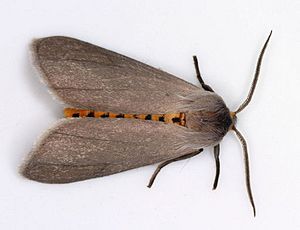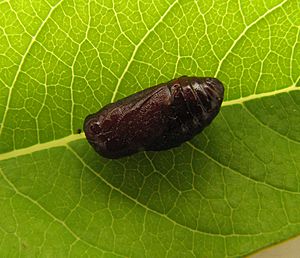Milkweed tiger moth facts for kids
Quick facts for kids Milkweed tiger moth |
|
|---|---|
 |
|
| Scientific classification | |
| Synonyms | |
|
The Milkweed Tiger Moth, also known as the Milkweed Tussock Moth, is a cool insect! Its scientific name is Euchaetes egle. This moth belongs to a group called tiger moths, which are part of the Erebidae family. A scientist named Dru Drury first described this species in 1773.
You can often spot these moths in the middle to late summer. They love to feed on milkweed plants and also on dogbane. Like many tiger moths, they have a special trick to stay safe. They get chemicals called cardiac glycosides from the plants they eat. These chemicals make them taste bad to predators.
Even adult moths keep these chemicals, which helps protect them from animals like bats. Scientists have found that these chemicals can stop bats from eating them. Adult moths can even make clicking sounds with special body parts called tymbal organs. This sound warns predators that they are not good to eat!
Contents
Where Milkweed Tiger Moths Live
You can find the Milkweed Tiger Moth across North America. They live from southern Canada all the way south through Texas and Florida.
Life Cycle of the Milkweed Tiger Moth
The Milkweed Tiger Moth goes through different stages in its life. In the northern parts of its range, there is usually one generation born each year. But in the warmer southern areas, there can be two or more generations annually.
Egg Stage
Female moths lay their eggs in groups. They usually place these egg masses on the underside of plant leaves.
Larva Stage (Caterpillar)
When they first hatch, the young caterpillars are a bit hairy and gray. They like to eat together in groups. These tiny caterpillars "skeletonize" leaves, which means they eat all the soft parts and leave only the lacy veins behind. They stay in groups until they are about halfway through their growth.
As they get older, the caterpillars grow tufts of black, white, and orange (sometimes yellow) hairs. Their head is black. Older caterpillars tend to wander more and can be seen alone or in small groups of 2 to 10. You can find mature caterpillars from June onwards. They can grow up to 35 millimeters long!
-
A caterpillar being attacked by a stink bug
Pupa Stage
After the caterpillar stage, the moth enters the pupa stage. The caterpillar builds a gray cocoon using its own hairs. The moth stays inside this cocoon during the winter months.
Adult Moth Stage
Adult Milkweed Tiger Moths have grayish wings. Their bodies are hairy and yellow, with a line of black dots down their back. Male moths use their tymbal organs to call to females. They also use these organs to make sounds that help defend themselves against bats.
What Milkweed Tiger Moths Eat
These moths mostly eat milkweed plants (Asclepias species) when they are caterpillars. Sometimes, they will also eat dogbane plants (Apocynum species).
Interestingly, the caterpillars often feed on older milkweed shoots. They usually don't share the same plants with Monarch butterfly caterpillars, who prefer younger shoots.
Milkweeds and dogbanes produce a sticky white liquid called latex. This latex can make it hard for caterpillars to eat. To avoid this, young caterpillars eat around the veins of the leaves. Older caterpillars are smarter! They cut the veins that carry the latex. This stops the latex from flowing to the part of the leaf they want to eat.






